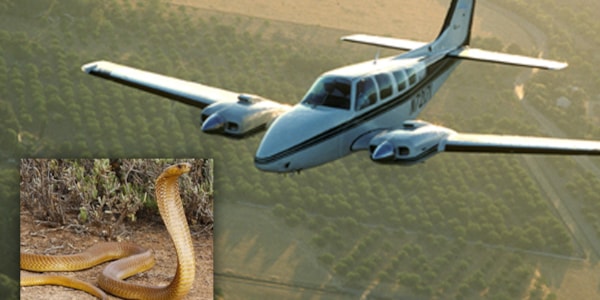Cobra slithers across pilots back, forcing him to make emergency landing

Snake photo in graphic from the African Snake Bite Institute
When Rudolf Erasmus felt something cold slide across his back while flying a Beechcraft Baron 58 at 11,000 feet in the air and when he glanced down, he saw a large Cape Cobra slithering under the seat.
Erasmus was flying with four passengers when he noticed the snake and made the quick decision to make an emergency landing. According to AP News, he still had to fly another 10-15 minutes before he could land the plane, with the snake curled up at his feet the whole time. Erasmus safely landed the plane, with the South African Civil Aviation Authority (SACAA) making a statement on his bravery and calm approach to a dangerous situation.
“On behalf of the Board, myself and the entire SACAA staff, we wish to congratulate Rudolf for his bravery and the way that he handled what could have been a major aviation incident in South Africa,” SACAA Director of Civil Aviation Poppy Khoza said. “He remained calm on a plane that was facing danger. Rudolf’s actions were textbook. In doing so, he was able to land safely without any harm to him and the fellow passengers on board, displaying to the world that he is an aviation safety ambassador of the highest order.”
Erasmus told CNN he thought it was his water bottle leaking at first, before he saw the head of the snake moving under the seat. He debated on telling the passengers but ultimately informed them there was a snake in the aircraft and they needed to bring the aircraft down to the ground as soon as possible, he told the BBC.
Multiple news outlets reported that workers at the Worcester flying club where the plane had taken off from said they had spotted a reptile hiding near the aircraft but after a quick search before the flight, they did not find the snake and believed it had left the aircraft. Even after the emergency landing and calls to a snake handler and emergency services and engineers stripping the plane, the snake remains missing. AP News reported the engineering company Erasmus works for needed the plane back in Mbombela, in Northern South Africa, so he made the flight knowing the snake could still be hiding in the aircraft.
“I informed the passengers, who are also my work colleagues, but luckily when I told them that we have a bit of an issue on board and a snake is under my seat, they all remained fairly calm and that helped to diffuse the situation,” Erasmus told SABC News. “The aircraft came to a complete stop and we shut it down. As I was standing on the wing, whilst moving the seat forward, I saw the snake curled up in a nice little bundle underneath my seat. We got the local snake handlers in Welkom, who tried for two days to catch the snake. By the time they arrived there, it had somehow vanished and it became a two-day mission trying to find the snake, but unfortunately with no success.”

Cape Cobra infographic from the African Snakebite Institue
According to the Encyclopedia Britannica, the Cape Cobra is the largest snake in southern Africa and one of the deadliest snakes in the region. The cobra can measure about five feet long but some can be as long as seven feet. These deadly snakes are thought to be shy snakes, mostly preying on mice, lizards and other small mammals. They typically hunt during the day and will even enter homes while pursuing prey. While a plane might not be an ideal place to find prey, this snake certainly made itself feel comfortable in the cockpit.
While the 2006 movie Snakes on a Plane may seem unrealistic, apparently some do slither on board from time to time.
On a United flight from Florida to New Jersey, a harmless garter snake slithered through the cabin, scaring passengers. According to the Guardian, while the plane taxied from the runway the passengers in the business-class cabin began to scream and pull their feet up off the floor. The snake was removed by animal-control officers and released into the wild and without injury to passengers and crew members or damage to the plane.
Newsweek reported that a snake was found in the cargo hold of a plane at Dubai International Airport, which caused disruptions and delays. The Air India Express plane had flown in from Calicut International Airport in Kerala, India, one of the busiest airports in the country.
La vibora voladora…ja ja ja. Una experiencia única en el Vuelo Torreón-México, vuelo 231 de Aeroméxico. Eso si…Prioridad en aterrizaje. pic.twitter.com/qwDk6Wtszw
— Indalecio Medina (@Inda_medina) November 6, 2016
In February 2022, an AirAsia flight in Malaysia was re-routed after a snake was discovered on board, according to CNN. CNN also reported that in 2012, the owner of a reptile shop smuggled a cobra in his carry-on on an Egyptair flight and it was found out when it escaped and bit his hand. In 2016 a Scottish woman returning from Australia discovered that a python had made its way into her luggage and had begun shedding its skin in her shoe. On an Aeromexico flight passengers noticed a snake dangling overhead, forcing the plane to make a quick landing to remove the scaly stowaway.
Perhaps this is the reason that iconic aircraft have taken their names from these slithery reptiles. The Bell AH-1W Super Cobra, AH-1 Cobra, Bell AH-1Z Viper and Sea Cobra all take their names from snakes, perhaps indicative of the ferocity and cunning ability of both the aircraft and its namesake.
This cobra seemed to enjoy its time in the sky, but most pilots are probably grateful it didn’t choose their cockpit to slither into.
Contact
Name: Haley Davoren
, Digital Content Manager
Company: GlobalAir.com
Website: https://globalair.com
Email: [email protected]
Phone: 502-456-3934
©2023 GlobalAir.com, Haley Davoren. All rights reserved.

Recent Comments